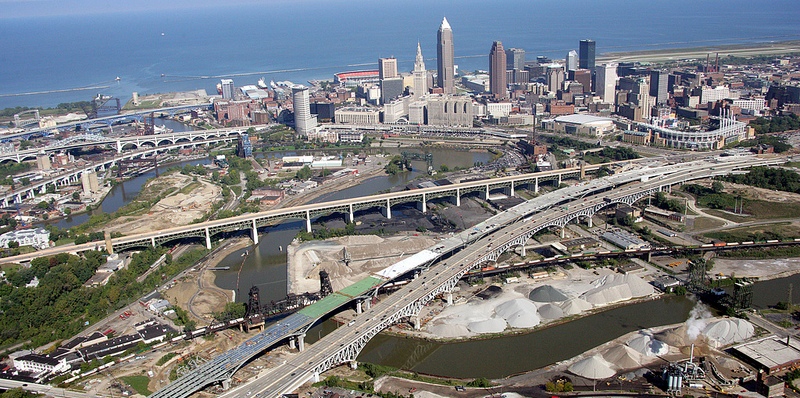About:
The George V. Voinovich Bridge replaces the old Innerbelt Bridge and is the third-generation river crossing at this location. It is a vital link into downtown Cleveland, spanning the Cuyahoga River on Interstate 90. Serving 140,000 motorists each day, it provides access to jobs, sports complexes, restaurants and more.
The 1959 “Pratt Deck Truss” bridge has been replaced with two, nearly identical spans – the one designed to carry westbound traffic, the second to carry eastbound traffic.
Replacement of the bridge is vital to the success of moving people in and out of downtown Cleveland now and in the future. It will enhance capacity, bolster our economy and ensure the safety of motorists. Both new bridges are now open to traffic and by late-October 2016 they will be fully open to five lanes in each direction.
In October 2008, ODOT engineers restricted traffic on the now-demolished 1959 truss bridge after inspections revealed that a number of steel members were aging faster than expected. After detailed analysis and subsequent repairs, ODOT reopened all lanes and ramps on the old truss bridge in November 2009.
In the meantime, during the spring of 2009, ODOT announced plans to construct a new westbound bridge - the first of a pair to replace the aging structure - utilizing stimulus funds made available through the American Recovery and Reinvestment Act.
Building a New Westbound Bridge (The First of Two NEW Bridges):
A ceremonial groundbreaking for the first new bridge was held in May 2011 and the bridge was opened in its entirety in November 2013. More than just a bridge, the westbound bridge project was the largest in ODOT’s history and employed as many as 500 people. The project earned national attention as one of the top 10 bridges in the nation and was featured on the cover of “Roads & Bridges” magazine in 2012. The $293 million project also received the “Environmental Excellence Award” from FHWA for its leadership and sustainability efforts.
Building a New Eastbound Bridge (The Second of Two NEW Bridges):
The second project demolished the 1959 truss bridge and constructed a second structure in its place. After months of mechanical demolition, the remaining steel skeleton of the 1959 Innerbelt Bridge was  demolished using explosives on July 12, 2014. Construction of the second bridge began immediately after.
demolished using explosives on July 12, 2014. Construction of the second bridge began immediately after.
The second bridge runs parallel to, and looks nearly identical to, the westbound structure. In the fall of 2013, the project was awarded to TGR and designer URS Corporation for a bid amount of $273 million. All major construction on the bridge is complete and it is partially open to traffic. By late-October 2016 both bridges will be fully open to five lanes in each direction. Minor construction operations will continue into spring 2017.
Building a Better Cleveland – One Bridge at a Time:
The combined replacement projects total well over half a BILLION dollars. When complete, each new bridge will carry five lanes of traffic when complete – one more than the 1959-era bridge. This will improve mobility providing better access to jobs, entertainment, commerce and more.
The bridges’ design is intended to mimic the curves of other bridges in the river valley, utilizing steel – an important part of Cleveland’s industrial history – while including modern touches like color-changing LED lighting systems. Areas around each new bridge will be enhanced with public overlooks, greenspaces, enhanced biking and walking facilities, additional parking, public art, community gardens and more.
ODOT undertook an extensive public involvement process during the enhancement process and hopes to capture the unique characteristics of the communities the new bridges touch.
Construction of each new bridge was performed using the unique “Best Value” Design Build Process – where the design and construction are combined in a single contract. This contracting method allows ODOT to select and award projects to a design-build team based on several factors including project cost, project delivery timing and impact to the traveling public. The “best-value” procurement process ensures the greatest return on taxpayer investment while still maintaining cost controls and high quality standards.
Maintaining Traffic During Construction:
I-90 remained open during construction, however lanes were restricted. The community had a primary alternate route available to avoid the active construction zones which was to “Opt for the Alternate” via I-490 and I-77 which had an extra lane added in each direction while traffic was restricted.
What’s Next?
Replacement of the 1959 Innerbelt Bridge is the first step in reconstructing the entire Innerbelt Corridor through downtown Cleveland. The multi-billion dollar “Innerbelt Plan” includes such safety improvements as flattening the sharp Innerbelt Curve and other reconstructions.

This aerial photo dated Sept 24, 2013 shows the 1959 truss bridge on the right.
The new westbound George V. Voinovich Bridge is on the left.